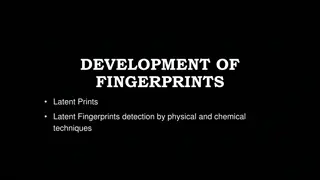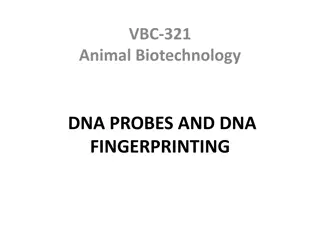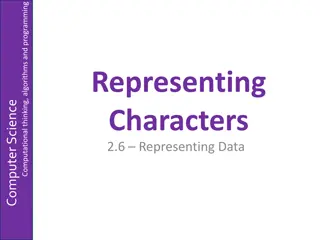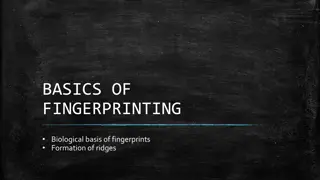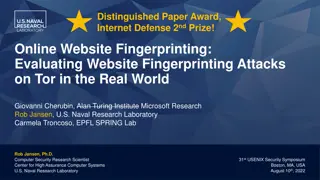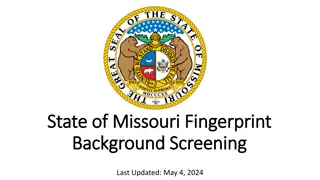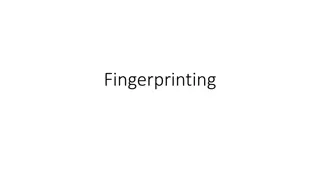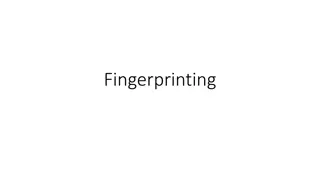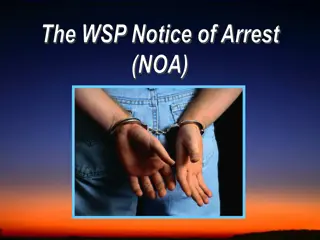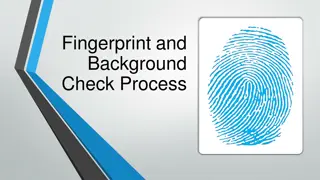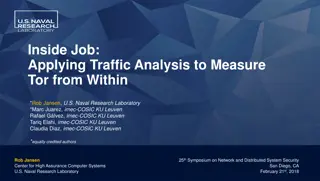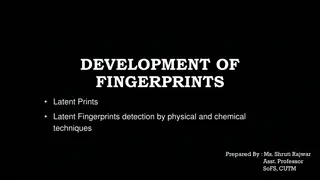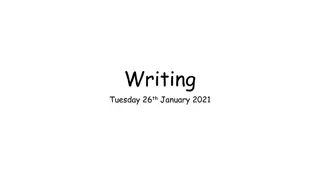Basics of Fingerprinting and Fingerprint Characters
Understanding the basics of fingerprinting is crucial in forensic investigations. Fingerprint characters such as spur, hook, trifurcation, bifurcation, and more play a key role in identifying individuals through their fingerprints. The process involves taking known prints by manual or direct methods, using specific equipment like inking plates, printers' ink, cardholders, and rollers. Proper technique is essential in obtaining clear and accurate prints for comparison and individualization purposes.
Download Presentation

Please find below an Image/Link to download the presentation.
The content on the website is provided AS IS for your information and personal use only. It may not be sold, licensed, or shared on other websites without obtaining consent from the author.If you encounter any issues during the download, it is possible that the publisher has removed the file from their server.
You are allowed to download the files provided on this website for personal or commercial use, subject to the condition that they are used lawfully. All files are the property of their respective owners.
The content on the website is provided AS IS for your information and personal use only. It may not be sold, licensed, or shared on other websites without obtaining consent from the author.
E N D
Presentation Transcript
BASICS OF FINGERPRINTING FINGERPRINT CHARACTERS/MINUTIAE PLAIN AND ROLLED FINGERPRINTS.
FINGERPRINT CHARACTERS Ridge characteristics or Galton details may take the following forms. Spur/hook Trifurcation Bifurcation Divergence Rod enclosed in recurving Enclosure or island Dot Short ridge Long ridge Ending ridge
Direct Known Prints Inked Prints in database Unknown Prints Latent Fingerprints
KNOWN PRINTS These are prints taken from a known source. Ultimate goal is to obtain good quality fingerprint from a known source so that it can be used for a variety of purposes, from searching to individualization. The terms known, direct, and inked are considered synonymous. The quality of these prints should be of sufficient clarity to allow for the comparison process to be conducted. These prints may also be known as ten print cards. Can taken by manual method (Inked)or direct.
MANUAL METHOD (INKED) : EQUIPMENT Inking Plate : Should be hard, rigid and must have scratch resistant surface Printer s Ink : Acts as a transfer medium. Dries quickly, easy to use and permanent. Cardholder : to hold the card flat to obtain proper surface Roller : 6X2in, provides uniform layer of ink on plate Fingerprint card : 8X8 inch identification card Coroner s spoon
Inking Plate Cardholder Roller Ink Fingerprint Card
MANUAL METHOD: PROCESS Plate inked by using a roller. Film should be almost transparent Preparation. Finger is rolled on inking plate from one side to another. Fingers should be pressed lightly on card and roll from side to side (cuticle to cuticle; finger : rolled away and thumb : rolled toward the center of the body). These are known as rolled impressions. For plain impressions: fingers should be inked at the same time and pressed onto the card simultaneously. Taking Prints
Fingers are rolled from awkward to easy position Fingers are rolled on inked slab Fingers are rolled on fingerprint card All the fingers are pressed simultaneously on FP card All four fingers are dabbed with ink on plate
ROLLED IMPRESSIONS AND PLAIN IMPRESSIONS Rolled fingerprints impressions are the ten individually-taken fingerprint images rolled from nail to nail. These are of larger size and contain more minutiae. Plain fingerprints impressions are taken simultaneously without rolling.These are referred to as plain, slap, or flat impressions. The individual s right and left four fingers should be captured first, followed by the two thumbs (4-4-2 method). Instituting this finger capture method ensures the highest level of fingerprint sequence accuracy. are used to verify the sequence and accuracy of the rolled impressions and are less affected by distortion and have clearer ridge structure.
PROBLEMS IN TAKING FINGERPRINTS MECHANICAL OPERATION: Poor impressions are usually caused by TEMPORARY DISABILITIES: Poor, thin ink / Insufficient inking Fresh cuts or wounds Failure to clean the inking apparatus and finger prior to printing Bandaged finger or fingers Occupational issues: Bricklayers, carpenters, dishwashers Alcohol or other commercial preparation may be used. Try using a small amount of ink. Perspiring fingers should be wiped dry (perspiring fingers will cause smeared fingerprints). Might also try using softening agents (oils/creams). Failure to completely roll the fingers fully from one side to the other Excessive perspiration Wash hands or wipe with alcohol. Use of too much ink PERMANENT DISABILITIES Allowing the fingers to slope or twist resulting in smears and blurs. (One of the biggest challenges is to take proper control of the subject being printed.) DEFORMED FINGERS
DIRECT PRINTS Direct prints are taken by the means of live scanner. With the manual method, proper inking of the prints is accomplished by ensuring the equipment is clean and in order. Live scans must adhere to the same basic principles. Live scan displays an image on a monitor to the fingerprint operator to register for printing. Advantage : If the operator does not like the print that was registered, that print can be eliminated and retaken before permanent registration onto the fingerprint card. Live scan system is not as messy as the manual method.
Finger being rolled on reader Fingerprints in live scan Automated Fingerprint Equipment (live scan) Live Scan palm prints
REFERENCES Fingerprints : Analysis and Understanding , Mark Hawthorne.



